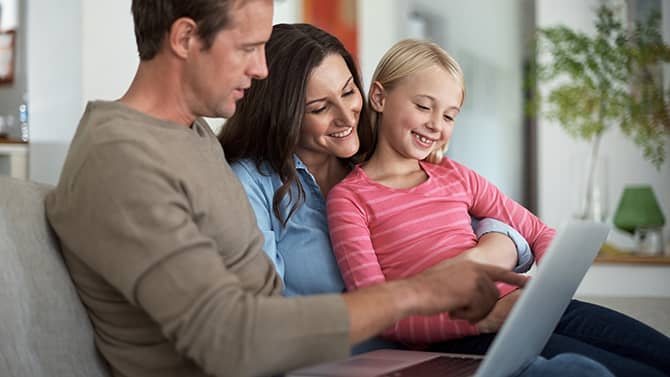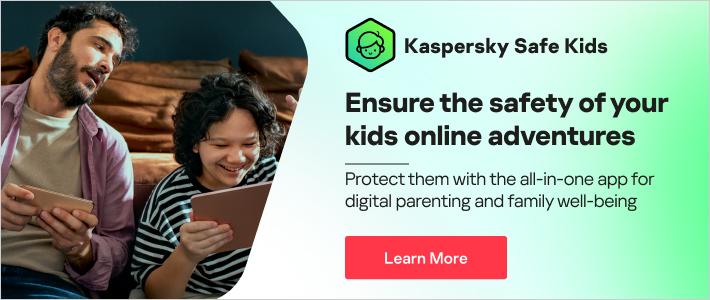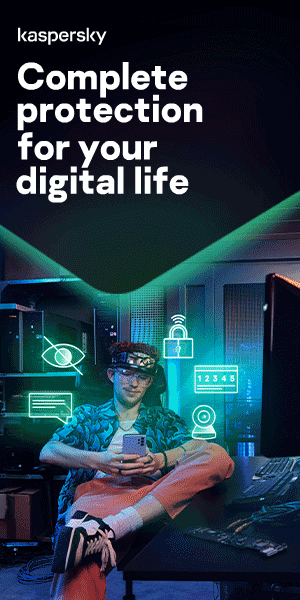How to create a family blog and family blogging safety tips

Starting a family blog could be a good option if you're looking for a project for the whole family to get involved with. Blogging can be an excellent way for families to stay connected – documenting your kids’ activities and achievements, writing about your travels, and generally keeping friends and families up to date with your life. Blogging with kids can be educational and provide parents with an opportunity to discuss online safety.
Which is better: a family blog or family website?
There is a difference between a family blog – a public blog that chronicles your family life, potentially attracting a wide readership in the process – and a private family website. A private family website enables you to share pictures and other information while maintaining a level of privacy you’re comfortable with. Private blogging sites allow you to 'lock' your family website pages, so only you and family members have access. Unlike social networking sites where everything is posted to a public forum, a private blog provides security features so only the people you want to can access your family website.
Blogging with kids – pros and cons
If you do decide to create a public-facing family blog, there are both advantages and disadvantages. These include:
Pros of a family blog:
Acts as a childhood journal: A family blog can act as a living childhood journal, one which your kids can enjoy looking back on with nostalgia.
Provides a record of your experiences as a parent: Some parents blog to show the reality of family life – to give a counterpoint to unrealistic portrayals of ‘perfect parenthood’. Blogging may help you reach out to other families, share your parenting story, and create a support network.
Provides a creative outlet for your children: Blogging with kids can help to improve your child's writing ability. Your kids may not always feel able to express themselves at school, and blogging can be a liberating format for written self-expression.
Provides teachable moments: Blogging can be educational and informative. Some of the topics you may choose to cover on a family blog could generate talking points that can help your kids understand different perspectives and points of view.
Keeping in touch with relatives and friends: A family blog can be a great way for extended families, especially those who live far apart, to keep in touch and close a gap that distance might otherwise widen.
Generating an income: It is possible to make money from blogs. Some parents may approach family blogging as a way to generate a side income.
Cons of a family blog:
Potential invasion of child privacy: Some may feel that public family blogs invade children’s privacy, especially when they are too young to consent to information being shared.
Potentially exploitative: Some may perceive children’s photos used to promote their parents' 'brand' in sponsored posts or for some other potentially exploitative monetary gain.
Potential for cyberbullying: As with many forms of online content, blogs could attract the attention of internet bullies and trolls.
Avoiding face-to-face communication: Blogs could be used as a tool to avoid face-to-face communication. Arguably, the more we rely on communicating through computers, the more we risk decreasing our ability to interact with others directly in person.
Online predators: A family blog could compromise children’s safety by placing personal information in the public domain.
Ultimately, if maximizing online privacy is your main concern, then a private blogging site that enables you to restrict access to your family members via password protection is probably the best way to go.
Family blog ideas
The best advice for any blogging is to focus on topics you are passionate about. There are numerous ideas and themes for family blogs, including:
- Family vacations
- Family history
- Hobbies and interests
- Healthy family meals and recipes
- Favorite family movies
- Family budgeting
- Family games
- Family sports
- Family pets
- Kids podcasts
- Kids fashion and hairstyles
- Kids room décor ideas
- Kids product reviews
- Pregnancy health and exercise
- Preparing for a new baby
Blogging can be very personal. People often read blogs because they want to know what is going on in someone’s life and see what they are really like. Whatever topic or theme you decide to blog about, the best advice is to keep things authentic. Resist the pressure to make everything sound perfect all the time. People tend to identify with others who have the same struggles and quirks they have.

How to create a family blog
If you decide to create a family blog, here are some of the critical steps to bear in mind:
1: Make sure your family is on board:
Before starting a family blog, make sure it is something that all members of your family want to do. A family blog puts your lives in the public eye, which brings up privacy concerns. You naturally don't want to publish content that could embarrass another family member or make them feel uncomfortable. So, it's worth discussing and agreeing as a family whether you want to start a public family blog.
2: Decide on hosting:
There are two ways to host your family blog – on your own domain or with a blogging platform. It's easy to register your own domain and doesn't cost too much through websites like Register.com, GoDaddy.com, and others. However, if a bespoke URL isn't important to you, and you're looking for the most straightforward option, then most blogging platforms will host your new site for free. While your URL will be something like ‘familyblog.wordpress.com’, the blogging platform will take care of most of the back-end technical details for you. Be aware, though, that if you want to customize your blog beyond the blogging platform’s strict parameters, you will need to pay a monthly fee to do so.
3. Choose your blog platform:
WordPress is one of the most popular blogging platforms, but there are plenty of alternatives you can consider, so it’s worth researching the best option for you. WordPress is popular because it is considered easy to modify and has an intuitive interface. For a small fee, it’s possible to customize the layout, colors, and header. Whichever blogging platform you choose, there are usually ‘how to’ guides available on YouTube and forums to help if you get stuck. There's a helpful comparison of the leading blogging platforms here.
4. Choose a suitable blog name:
Some family bloggers like to include their last names in their blogs so that readers can identify them, but that obviously raises online privacy concerns. To overcome this, you could use an alias or nickname instead. Brainstorm blog name ideas with family members. Choose something memorable – consider the use of alliteration and use the dictionary or thesaurus for inspiration. Whatever name you decide, conduct a thorough internet search to check it hasn’t already been used.
5. Customize with plug-ins:
Plug-ins allow you to customize your blog even if you don’t necessarily have in-depth technical knowledge. Familiarize yourself with the plug-ins offered by your blogging platform – for example, features that enable you to create photo galleries, add videos, let users subscribe by e-mail, track your stats, and more. These will make your site more engaging for visitors. You can quickly install plug-ins, and these can help make posting easier for you.
6. Determine your niche and your audience:
What is your niche? Who is your audience? If you can answer these questions clearly, your blog is more likely to be successful. If you are simply creating a private blog to share with your family and close friends, you don’t have to worry too much about these questions. But if you want to reach a larger audience, you will probably want to put some extra thought into it.
7. Decide who will write the posts:
Will you be the primary author of the blog? Will your partner and children be contributing, too? You can set everyone up with their own username and login, and everyone can post as they wish.
8 Start posting:
While it may appear intimidating at first, the more posts you write, the easier it will seem. Remember, the role of a blogger is not to impress anyone. A blogger simply needs to write about what they feel like, and people will start following along the way. Also, remember that written posts are not the only kind of content you can publish. You can also share slideshows, videos, audio, and so on.
9. Tell your friends and family:
The people who will initially be the most interested in your family blog will be your friends and family. Show them your blog and – assuming you don’t want the blog to remain private and password-protected – ask them to spread the word about it with others they know and through social media. For many bloggers, knowing that people are reading their content is what inspires them to keep writing.
Suppose you decide to make your blog private. In that case, so that it’s password-protected and accessible only to specific followers – you can usually do so in the privacy settings of your blogging platform. For example, WordPress contains guidance on private blogging here.
Family blogging – online safety tips
Creating a blog as a family is not only fun – it can also give parents the opportunity to talk to their children about online safety. Some of the online safety tips to bear in mind when blogging with kids include:
Use strong passwords:
When creating your blogger account, be sure to talk to your kids about the importance of strong passwords and help them create one. A strong password is:
- At least 12 characters or longer and comprises a mix of upper- and lower-case letters plus symbols and numbers.
- Avoids the obvious – such as sequential numbers (“1234”) or personal information that someone who knows you might guess, such as your date of birth or a pet’s name.
To make your passwords more complex, you could consider creating a 'passphrase' instead. Passphrases involve picking a meaningful phrase that is easy to remember and then making the first letter of every word the password.
Understand security settings:
Take the time to familiarize yourself and understand the security settings of the blogging website that you are using. Many blog platform sites allow you to keep your blogs private and add readers – this is a good option for those who want to create a private blog.
Use two-factor authentication:
Two-factor authentication (TFA or 2FA) is an additional security measure that you can implement. Two-factor authentication requires two separate, distinct forms of identification to access something. The first factor is a password, and the second commonly includes a text with a code sent to your smartphone or biometrics using your fingerprint, face, or retina. Where possible, enable multi-factor authentication on your accounts.
Be mindful of online reputation:
If your blog is public, consider the potential impact of what you’re posting. Ask yourself, does this photo, status update, or blog article build a positive reputation for my child? Does this information reveal physical or mental challenges that could potentially resurface years later when my child applies for a job or college? Everything we post online—and everything that others post about us—contributes to our permanent, digital reputation.
Don’t post vacation photos until later:
You don’t want anyone and everyone to know where you are at all times. If people know you are away from home, they also know your home is potentially empty and vulnerable. Instead of sharing travel photos in real-time, create a vacation album when you return and make sure it is clearly labeled as post-trip.
Limit identifiers in photos or posts about your kids:
Consider using nicknames or aliases for your children online. Be careful about what is visible in photos with your children. Don’t post pictures of your house where the house number may be visible or mention what neighborhood you live in. Specific details like a school sign in the background can give people an idea of your children’s whereabouts.
Avoid sharing information about your child’s school:
Lots of fun things take place at your child’s school – concerts or open days or sporting events, and so on. But it's not a good idea to share the name of your child's school on social media or your blog – doing so could put your child's safety at risk. If your child has a distinctive school uniform with a recognizable logo or emblem on it, think twice before sharing pictures of it.
Avoid sharing dates of birth:
You may want to share photos of your child on their birthday but be careful about sharing their actual date of birth. If you share pictures of their birthday, you can be vague and non-specific about the date. A date of birth is the kind of information that could be useful to a cybercriminal.
Screen the content:
If your kids author family blog posts, ask them to show you what they are about to post before publishing them. Discuss potential problems and explain why certain content may or may not be appropriate to publish online.
Use a parental control app:
Parents looking to maximize their child's safety online could consider using a parental control app like Kaspersky Safe Kids - this allows you to block adult content, manage access to inappropriate games and apps, and manage screen time by device.
In addition, using a good quality antivirus will also help keep you and your family safe online. Kaspersky Total Security works 24/7 to protect your devices and data, blocking threats like viruses, malware, ransomware, spy apps, and all the latest hacker tricks.
Related articles:
How to create a family blog and family blogging safety tips
Kaspersky
We use cookies to make your experience of our websites better. By using and further navigating this website you accept this. Detailed information about the use of cookies on this website is available by clicking on more information.






